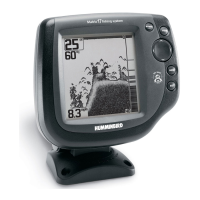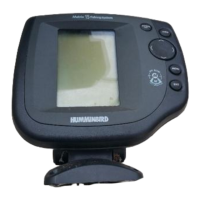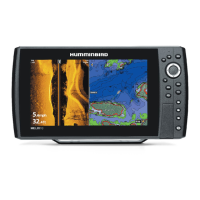Do you have a question about the Humminbird Matrix 17 and is the answer not in the manual?
Describes the fundamental principles of sonar operation.
Explains how sonar signals are sent and received.
Explains 200 kHz single beam sonar with 20° coverage.
Explains 200/83 kHz DualBeam PLUS with 60° coverage.
Explains 90° coverage with 455 kHz beams and DualBeamPLUS.
Details like Depth, Speed, Temp, Timer, Distance, Average Speed, Bait Ball, Hard Bottom, Rocky Bottom, Second Sonar Return.
Describes cursor positioning and the dialog box for depth readings.
Explains fish icons, structure, and fish symbols based on sonar returns.
Explains thermoclines, soft bottom, RTS window, and battery voltage display.
Lists the various display modes available on the system.
Explains how to switch between different display views using keys.
Describes the Sonar View as a historical log of sonar returns.
Details elements like depth, temperature, triplog, and RTS window in Sonar View.
Explains how to freeze the display and use the cursor.
Explains how the display represents sonar data over time.
Explains the RTS Window's role in displaying real-time sonar returns.
Describes the Narrow RTS Window using grayscale for intensity.
Describes the Wide RTS Window using bar graphs for intensity.
Explains how Zoom View enhances resolution for close targets.
Describes the split display and preview box in Zoom View.
Explains comparing 83 kHz and 200 kHz returns side-by-side.
Notes that digital readouts are not customizable in this view.
Describes the view for large, easy-to-read digital data.
Details data like depth, temperature, speed, and triplog.
Explains viewing left/right 455 kHz beams and 200 kHz down-looking beam.
Describes coverage area for side beams based on depth setting.
Explains charting depth changes to create a bottom contour profile.
Describes how bottom types (Hard, Soft, Rocky) appear on display.
Explains Inverse method with dark pixels for weak returns.
Explains Structure ID with light pixels for weak returns.
Explains WhiteLine highlighting strongest returns in white.
Explains Bottom Black for high contrast with black bottom contour.
Controls power, backlight, and contrast settings.
Cycles through available display views.
Accesses Start-Up, X-Press, and Main Menu systems.
Navigates menus and positions cursors.
Cancels alarms, exits menus, cycles views, and exits Freeze Frame.
Allows connection of accessories to expand system features.
Describes the process of turning on the Matrix Fishing System.
Menu for selecting operation mode at power up.
Provides quick access to frequently used settings.
Organizes settings into Alarms, Sonar, Setup, and Accessories tabs.
Sets system to Normal (simple) or Advanced (full control) mode.
Explains how view updates immediately after menu changes.
Standard on-water operation with a connected transducer.
Tool for learning system operation without actual water use.
Recommends manual selection for full simulator benefits.
Displays results from internal diagnostic self-test.
Lists connected accessories and their status.
Used to update unit software via a PC.
Controls display detail by adjusting sonar return visibility.
Sets the shallowest depth range displayed in views.
Sets the deepest depth range displayed on the screen.
Determines speed at which sonar information moves across the display.
Selects how bottom and structure are represented on the display.
Sets the magnification level for the Sonar Zoom View.
Selects which sonar returns from the transducer are displayed.
Displays fish symbols when selective requirements are met.
Adjusts the threshold of the Fish ID detection algorithms.
Sets the RTS Window to Wide, Narrow, or Off.
Changes the sensitivity of the 83 kHz beam.
Adjusts the sensitivity of the 455 kHz beam.
Divides the display into four equal sections with horizontal depth lines.
Adjusts filter to remove surface clutter noise from algae and aeration.
Limits interference from sources like boat engine or turbulence.
Adjusts the maximum depth of operation for the fishing system.
Configures the unit for operation in fresh or salt water.
Allows selection of the transducer to be used with the unit.
Sounds when the depth becomes equal to or less than the menu setting.
Sounds when the system detects fish matching the alarm setting.
Sounds when the input battery voltage drops below the set threshold.
Selects the pitch of the alarm sound.
Configures units for depth measurements (Meters, Feet, Fathoms).
Configures units for temperature measurements (Celsius, Fahrenheit).
Configures units for distance measurements (Miles, Kilometers).
Configures units for speed measurements (kph, mph, kts).
Sets the menu system to Normal or Advanced mode.
Selects the display language for menus.
Resets the Triplog to zero for timer, distance, and average speed.
Resets all menu settings to their factory defaults.
Sets available views to either hidden or visible in rotation.
Selects digital readouts for fixed-position data windows on the Sonar View.
Adjusts digital depth readout from waterline or keel.
Adjusts the temperature readout by a specified amount.
Adjusts the speed readout by a percentage.
Turns NMEA data output on or off.
Guides on checking power connections and fuse for startup issues.
Troubleshoots issues where the unit defaults to Simulator mode.
Addresses problems like power loss at high speeds or weak sonar readings.
Identifies sources of electrical noise affecting display readings.
Provides real-time speed and temperature readouts and Triplog.
Provides barometric pressure and trend data.
Accesses GPS, trackplotter, and navigation capabilities.
Connects handheld or other NMEA GPS-compatible devices.
Receives remote sonar signals from SmartCast sensors.
Connects to PC for software updates and new features.
Details the maximum depth the unit can measure.
Specifies the power output in RMS and Peak to Peak.
Lists the operating frequencies for different sonar types.
Defines the beam angles and coverage areas at specific frequencies.
Specifies the minimum distance for distinguishing targets.
Indicates the required power input voltage range.
Lists the pixel resolution for different LCD models.
Lists compatible transducer models for the system.
Specifies the length of the transducer cable.
Provides information regarding the WEEE Directive and product disposal.
Provides telephone and email contact information for customer support.
Lists the physical address for direct shipping.
Describes the fundamental principles of sonar operation.
Explains how sonar signals are sent and received.
Explains 200 kHz single beam sonar with 20° coverage.
Explains 200/83 kHz DualBeam PLUS with 60° coverage.
Explains 90° coverage with 455 kHz beams and DualBeamPLUS.
Details like Depth, Speed, Temp, Timer, Distance, Average Speed, Bait Ball, Hard Bottom, Rocky Bottom, Second Sonar Return.
Describes cursor positioning and the dialog box for depth readings.
Explains fish icons, structure, and fish symbols based on sonar returns.
Explains thermoclines, soft bottom, RTS window, and battery voltage display.
Lists the various display modes available on the system.
Explains how to switch between different display views using keys.
Describes the Sonar View as a historical log of sonar returns.
Details elements like depth, temperature, triplog, and RTS window in Sonar View.
Explains how to freeze the display and use the cursor.
Explains how the display represents sonar data over time.
Explains the RTS Window's role in displaying real-time sonar returns.
Describes the Narrow RTS Window using grayscale for intensity.
Describes the Wide RTS Window using bar graphs for intensity.
Explains how Zoom View enhances resolution for close targets.
Describes the split display and preview box in Zoom View.
Explains comparing 83 kHz and 200 kHz returns side-by-side.
Notes that digital readouts are not customizable in this view.
Describes the view for large, easy-to-read digital data.
Details data like depth, temperature, speed, and triplog.
Explains viewing left/right 455 kHz beams and 200 kHz down-looking beam.
Describes coverage area for side beams based on depth setting.
Explains charting depth changes to create a bottom contour profile.
Describes how bottom types (Hard, Soft, Rocky) appear on display.
Explains Inverse method with dark pixels for weak returns.
Explains Structure ID with light pixels for weak returns.
Explains WhiteLine highlighting strongest returns in white.
Explains Bottom Black for high contrast with black bottom contour.
Controls power, backlight, and contrast settings.
Cycles through available display views.
Accesses Start-Up, X-Press, and Main Menu systems.
Navigates menus and positions cursors.
Cancels alarms, exits menus, cycles views, and exits Freeze Frame.
Allows connection of accessories to expand system features.
Describes the process of turning on the Matrix Fishing System.
Menu for selecting operation mode at power up.
Provides quick access to frequently used settings.
Organizes settings into Alarms, Sonar, Setup, and Accessories tabs.
Sets system to Normal (simple) or Advanced (full control) mode.
Explains how view updates immediately after menu changes.
Standard on-water operation with a connected transducer.
Tool for learning system operation without actual water use.
Recommends manual selection for full simulator benefits.
Displays results from internal diagnostic self-test.
Lists connected accessories and their status.
Used to update unit software via a PC.
Controls display detail by adjusting sonar return visibility.
Sets the shallowest depth range displayed in views.
Sets the deepest depth range displayed on the screen.
Determines speed at which sonar information moves across the display.
Selects how bottom and structure are represented on the display.
Sets the magnification level for the Sonar Zoom View.
Selects which sonar returns from the transducer are displayed.
Displays fish symbols when selective requirements are met.
Adjusts the threshold of the Fish ID detection algorithms.
Sets the RTS Window to Wide, Narrow, or Off.
Changes the sensitivity of the 83 kHz beam.
Adjusts the sensitivity of the 455 kHz beam.
Divides the display into four equal sections with horizontal depth lines.
Adjusts filter to remove surface clutter noise from algae and aeration.
Limits interference from sources like boat engine or turbulence.
Adjusts the maximum depth of operation for the fishing system.
Configures the unit for operation in fresh or salt water.
Allows selection of the transducer to be used with the unit.
Sounds when the depth becomes equal to or less than the menu setting.
Sounds when the system detects fish matching the alarm setting.
Sounds when the input battery voltage drops below the set threshold.
Selects the pitch of the alarm sound.
Configures units for depth measurements (Meters, Feet, Fathoms).
Configures units for temperature measurements (Celsius, Fahrenheit).
Configures units for distance measurements (Miles, Kilometers).
Configures units for speed measurements (kph, mph, kts).
Sets the menu system to Normal or Advanced mode.
Selects the display language for menus.
Resets the Triplog to zero for timer, distance, and average speed.
Resets all menu settings to their factory defaults.
Sets available views to either hidden or visible in rotation.
Selects digital readouts for fixed-position data windows on the Sonar View.
Adjusts digital depth readout from waterline or keel.
Adjusts the temperature readout by a specified amount.
Adjusts the speed readout by a percentage.
Turns NMEA data output on or off.
Guides on checking power connections and fuse for startup issues.
Troubleshoots issues where the unit defaults to Simulator mode.
Addresses problems like power loss at high speeds or weak sonar readings.
Identifies sources of electrical noise affecting display readings.
Provides real-time speed and temperature readouts and Triplog.
Provides barometric pressure and trend data.
Accesses GPS, trackplotter, and navigation capabilities.
Connects handheld or other NMEA GPS-compatible devices.
Receives remote sonar signals from SmartCast sensors.
Connects to PC for software updates and new features.
Details the maximum depth the unit can measure.
Specifies the power output in RMS and Peak to Peak.
Lists the operating frequencies for different sonar types.
Defines the beam angles and coverage areas at specific frequencies.
Specifies the minimum distance for distinguishing targets.
Indicates the required power input voltage range.
Lists the pixel resolution for different LCD models.
Lists compatible transducer models for the system.
Specifies the length of the transducer cable.
Provides information regarding the WEEE Directive and product disposal.
Provides telephone and email contact information for customer support.
Lists the physical address for direct shipping.
| Brand | Humminbird |
|---|---|
| Model | Matrix 17 |
| Category | Fish Finder |
| Language | English |











